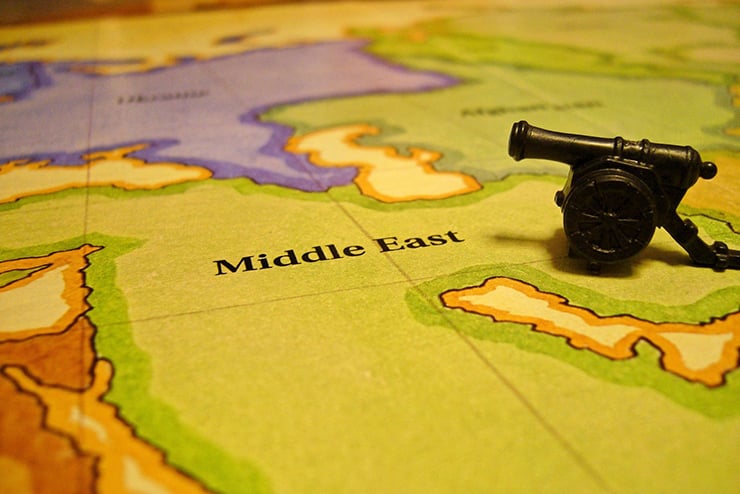Sometimes events, even spectacular events, like the attack on Israel on Oct. 7, 2023 and the ongoing war in Gaza, can conceal rather than reveal realities.
We’ve been blasted for months with horrified coverage—increasingly and curiously, of the suffering of Arabs in Gaza, rather than of the particularly awful attack that started the war. That has served to obscure just how nasty, bloodthirsty, and vicious the normal state of things is in the Middle East and neighboring areas. By comparison, what has transpired since Oct. 7 is a trickle, compared to the rivers of blood in other wars in the region. Yet media coverage has reinforced the obsessive focus on the Arab-Israeli struggle even as, contrary to what is widely supposed, that conflict is not the main or even most violent of all the many conflicts in the Middle East. It is par for the course in that neighborhood, but many other conflicts have surpassed it.
Indeed, during the 1950s and throughout much of the 1960s, the Arab-Israeli conflict often reached a stalemate. Until the mid-1950s, Israel’s victory in 1948-1949 as well as the arms control regime imposed by the Western countries in 1950, prevented a renewal of the war against Israel. This began to change with the Soviet arms deals with Egypt and Syria. Yet even then the Arab-Israeli struggle was usually overshadowed by the struggle between the radical nationalist revolutionary states and the more conservative Arab states against the West. It was those conflicts, not the Arab-Israeli conflict, which precipitated the Soviet entry into the Arab world, and this involvement lasted into the 1970s. Moreover, the longest international war in the region was not a war between Arabs and Israelis, but the war between Iran and Iraq in the 1980s.
In other words, compared to many wars and conflicts elsewhere in the region, the Arab-Israeli struggle has been a small affair in terms of casualties.
From 1948 up to the current war, just under 25,000 Israelis were killed, as against probably some 91,000 Arabs. Accurate statistics for war losses for Iran in its war with Iraq are hard to find, since sources vary wildly. But at a minimum that war probably cost 305,000 military deaths and 100,000-plus civilians killed. Thus, the usually neglected civil wars that raged in Arab countries make the struggles with Israel look nearly bloodless by comparison. Some 150,000 people are estimated to have been killed in the Algerian civil war of 1992-2002. The civil war in Lebanon from 1975 to 1990, cost a minimum of 120,000 lives.
Yemen has survived several civil wars. The war between Royalists and Republicans—backed by Egyptian military forces using mustard gas—apparently took a minimum of 100,000 lives between 1962 and 1970. That is about as many as all the people killed in all the Arab-Israeli wars!
Yemen’s most recent civil war apparently has killed 377,000 people. The continuing civil war in Syria may have already cost some 300,000 lives; the Russian forces alone killing over 18,000. Though they do not exactly count as civil wars, the Iraqis have killed large numbers of their Kurdish minority (also with poison gas), the Arabs of the Northern Sudan, as well as many pagans and Christians in what is now South Sudan. The sectarian fighting among Iraqis, between Sunnis and Shiites, and the attacks on Yezidis and Druze seem to be equally ignored.
With all due disrespect to the despicable murderers of Hamas, it must be said that, while trying hard, they did not change the rule that in the Middle East, Arabs and Iranians have been vastly more effective in killing each other, and various ethnic minorities, than in killing Israelis.
Yet all these other struggles only barely surface in the maunderings of the Western news media, except, sometimes, as a justification for allowing refugees or alleged refugees from these conflicts to resettle in Western countries. Apparently, it is big news if Arabs kill Israelis, bigger news if Israelis kill Arabs—note how fast the coverage of the massacre of Oct. 7 has been replaced with outrage at Israel’s effort to prevent a repetition of that tragedy—with increasingly few examining real causes. It seems to be no news at all if Muslims and minorities in the Arab countries kill each other. Apparently, it is not who is killed, or how many, but who is doing the killing, that determines Western media coverage.
Along with that comes another point that is often ignored by modern Westerners, even avowed Christians: the vicious persecution of Christians in the Muslim world. Almost all news media and certainly academia have treated these atrocities as a deep secret.
The real, deep secret of the Middle East, however, may not be what is happening there, but what many Westerners imagine is going on there.

Leave a Reply